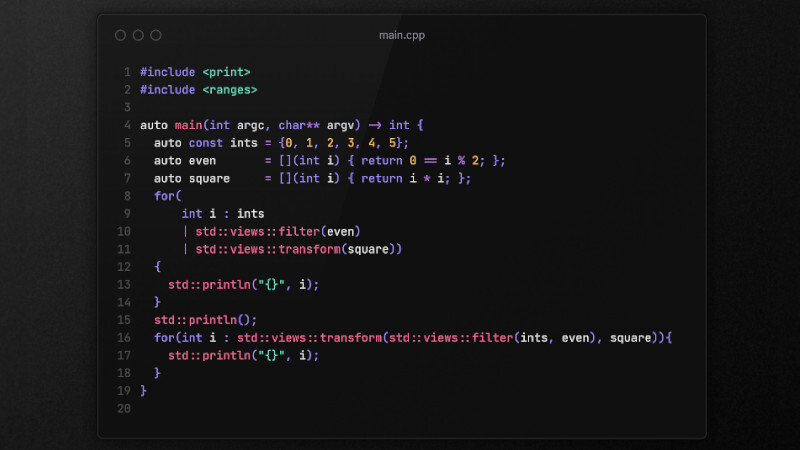![]()
Não julgue a imagem! =) Essa foi uma das primeiras Pixel Art que eu fiz com LibreSprite ! 😃
Então, é Natal! Que tal aproveitarmos essa data ímpar do ano para treinarmos mais um pouquinho do nosso conhecimento em C++?
Nesse artigo vamos ver três formas de criarmos nossa Árvore de Natal com C++, incluindo formas no terminal e também com OpenGL e SFML. 🎄
1º Forma, a mais básica possível
Se criarmos um loop aninhado podemos desenhar diversas formas geométricas, no entanto, a mais treinada é um triângulo. No código abaixo, conseguimos fazer um triângulo reto, ou seja, para nossa solução, seria metade do problema resolvido.
Note que pus a função separada para que possamos customizar o tamanho do triângulo que queiramos
vim 01-christmas-tree.cpp
#include <iostream>
void drawTree(int min, int max){
for (int i = min; i <= max; ++i){
for (int x = 0; x < i; ++x){
std::cout << "*";
}
std::cout << '\n';
}
}
int main(){
drawTree(1,4);
return 0;
}Após compilar e rodar teremos a possível saída abaixo:
g++ 01-christmas-tree.cpp && ./a.out
*
**
***
****Ou seja, somente algums básicas linhas! Se quiser um pouco maior, basta alterar a função drawTree() para 1,10 ou qualquer número que você queira:
...
drawTree(1, 10);
....E então, teremos um tamanho ligeiramente maior:
*
**
***
****
*****
******
*******
********
*********
**********Mas, queremos mesmo ter um triâgulo equilátero(bom, não é tão equilátero assim, mas tá valendo! :) ), logo, adicionaremos mais dois loops dentro do loop principal com cálculos que crie a parte esquerda do triângulo e dê espaço à esquerda, além de remover o parâmetro min para que possamos mostrar todo o triângulo, veja o código para notar a diferença:
#include <iostream>
void drawTree(int max){
for (int i {}; i < max; ++i){
for (int x {}; x < max; ++x){
std::cout << " ";
}
for (int j = max - i; j > 0; j--){
std::cout << " ";
}
for (int k {}; k < 2 * i + 1; ++k){
std::cout << "*";
}
std::cout << '\n';
}
}
int main(){
drawTree(10);
return 0;
}Agora ficou legal! Podemos ainda customizar o tamanho via argc e argv, mas isso aí fica com você! 😃
*
***
*****
*******
*********
***********
*************
***************
*****************
*******************2º Forma - Uma Árvore de Natal mais estilosa e com animação!
Nessa outra forma vamos incrementar mais alguns caracteres ASCII para ficar mais legal, também vamos usar a biblioteca unistd.h para obtermos um lag(sleep) de 1 segundo na troca da aniimação, para mais detalhes veja o artigo: 4 Formas diferentes de usar sleep() em C++ .
Além também de adicioarmos CORES! Para isso vamos usar uma biblioteca que criamos aqui mesmo no blog, para mais detalhes veja o artigo: Crie sua própria biblioteca de cores para C++ . O legal dessa biblioteca é que ela é simples e funciona legal no LSP, veja o gif abaixo ele informando cada string, note que ele informa: sublinhado, itálico, normal, background e entre outros:
![]()
Ou seja, copie o código da postagem e salve em um arquivo de nome colors.hpp e deixe no mesmo diretório do código abaixo!
O código em resumo será:
vim 02-christmas-tree.cpp
#include <iostream>
#include <unistd.h>
#include "colors.hpp" // inclui as cores
int main(){
srand(time(NULL));
for (;;) {
for (int x = 0; x < 20; x++) {
for (int y = 0; y < 22 - x; y++)
std::cout << " ";
for (int i = 0; i <= x * 2; i++) {
int randm = rand() % 40;
if (randm ==i)
{
std::cout << hey::white << "O";
}
else if (randm + i % 2 == 0) {
std::cout << hey::red << "@";
}
else {
std::cout << hey::green << "*";
}
}
std::cout.put('\n');
}
for (int t = 0; t < 3; t++) {
for (int o = 0; o < 19; o++) {
std::cout << hey::white << " ";
}
std::cout << hey::white << "| |\n";
}
sleep(1);
system("clear");
}
}Compile e rode:
g++ 02-christmas-tree.cpp && ./a.out
A árvore possívelmente aparecerá assim:
![]()
3º Forma - Usando C++ com SFML e OpenGL
E por final temos com SFML e OpenGL, esse exemplo eu encontrei na internet, só fiz algumas modificaçãozinhas!
Leia o código para mais detalhes, mas antes prepare um diretório para os arquivos:
mkdir christmas-tree
cd christmas-tree
vim tree.{hpp,cpp} main.cpp Makefile
tree.hpp
#pragma once
#include <SFML/Graphics.hpp>
#include <SFML/OpenGL.hpp>
#include <unistd.h>
#include <cmath>
#include <memory>
class ChristmasTree {
std::shared_ptr<sf::RenderWindow> window;
public:
ChristmasTree();
void events();
void draw();
void run();
void lineto(float,float,float,float);
void tree(float,float,float,float);
};
tree.cpp
#include "tree.hpp"
ChristmasTree::ChristmasTree(){
window = std::make_shared<sf::RenderWindow>(
sf::VideoMode(400, 600),
"Christmas Tree: C++, OpenGL and SFML",
sf::Style::Titlebar | sf::Style::Close
);
window->setPosition(sf::Vector2i(0, 0));
window->setFramerateLimit(30);
glOrtho(0.0, window->getSize().x, window->getSize().y, 0.0, 1.0, -1.0);
}
void ChristmasTree::events(){
auto e = std::make_shared<sf::Event>();
while( window->pollEvent( *e ) ){
if( e->type == sf::Event::Closed){
window->close();
}
}
}
void ChristmasTree::draw(){
window->clear(sf::Color::Black);
glColor3f(0.0, 1.0, 0.0);
lineto(210.0, 400.0, 160.0, M_PI/2.0);
tree(210.0, 400.0, 75.0, -M_PI/2.0);
window->display();
usleep(10000);
}
void ChristmasTree::run(){
while( window->isOpen() ){
events();
draw();
}
}
void ChristmasTree::lineto(float x, float y, float len, float angle) {
glBegin(GL_LINES);
glVertex2f(x, y);
glVertex2f(x+len*cos(angle), y+len*sin(angle));
glEnd();
}
void ChristmasTree::tree(float x, float y, float len, float angle){
const float strange_angle = M_PI/24.0;
lineto(x, y, len, angle+strange_angle);
lineto(x, y, -len, angle);
lineto(x, y, len, angle+2*M_PI/3.0+strange_angle);
lineto(x, y, len, angle-2*M_PI/3.0+strange_angle);
const float len_min = 2.0;
if(len > len_min){
const float len_div = 0.4;
tree(x+len*cos(angle+strange_angle),
y+len*sin(angle+strange_angle),
2*len*len_div, angle+strange_angle);
tree(x+len*cos(angle+2*M_PI/3.0+strange_angle),
y+len*sin(angle+2*M_PI/3.0+strange_angle),
len*len_div, angle+2*M_PI/3.0+strange_angle);
tree(x+len*cos(angle-2*M_PI/3.0+strange_angle),
y+len*sin(angle-2*M_PI/3.0+strange_angle),
len*len_div, angle-2*M_PI/3.0+strange_angle);
}
}
main.cpp
#include "tree.hpp"
int main( int argc , char **argv ){
auto cmas = std::make_shared<ChristmasTree>();
cmas->run();
return 0;
}
Makefile
TARGET=a.out
CXX=g++
DEBUG=-g
OPT=-O0
WARN=-Wall
SFML=-lsfml-graphics -lsfml-window -lsfml-system -lGL
CXXFLAGS=$(DEBUG) $(OPT) $(WARN) $(SFML)
LD=g++
OBJS= main.o tree.o
all: $(OBJS)
$(LD) -o $(TARGET) $(OBJS) $(CXXFLAGS)
@rm *.o
@./$(TARGET)
main.o: main.cpp
$(CXX) -c $(CXXFLAGS) main.cpp -o main.o
tree.o: tree.cpp
$(CXX) -c $(CXXFLAGS) tree.cpp -o tree.oAgora é só compilar e rodar:
makeSaída:
![]()
Show de bola, né?!
Queria desejar Boas Festas e um Feliz Natal para tod@s vocês!





